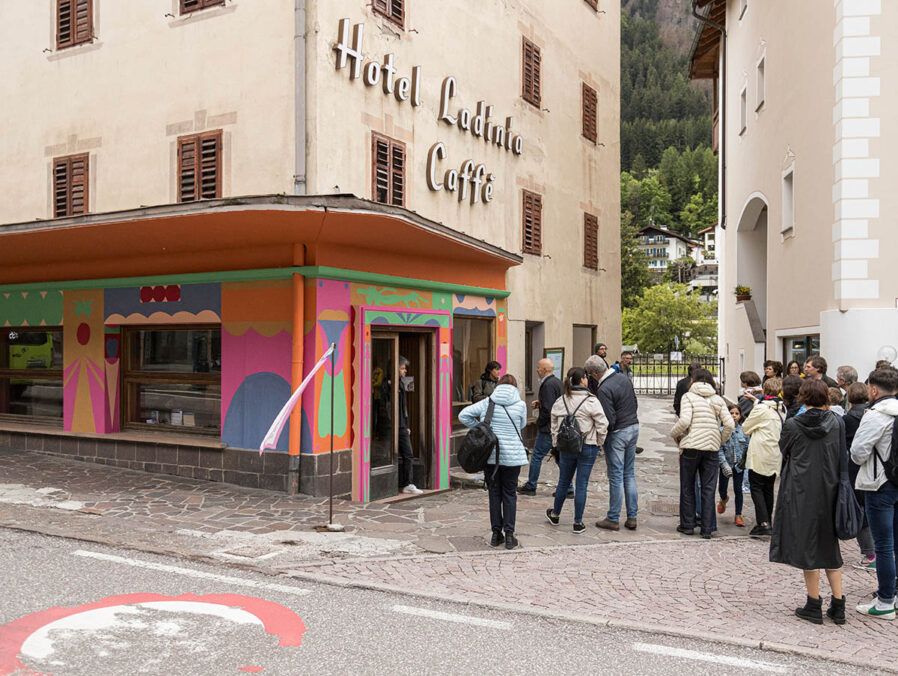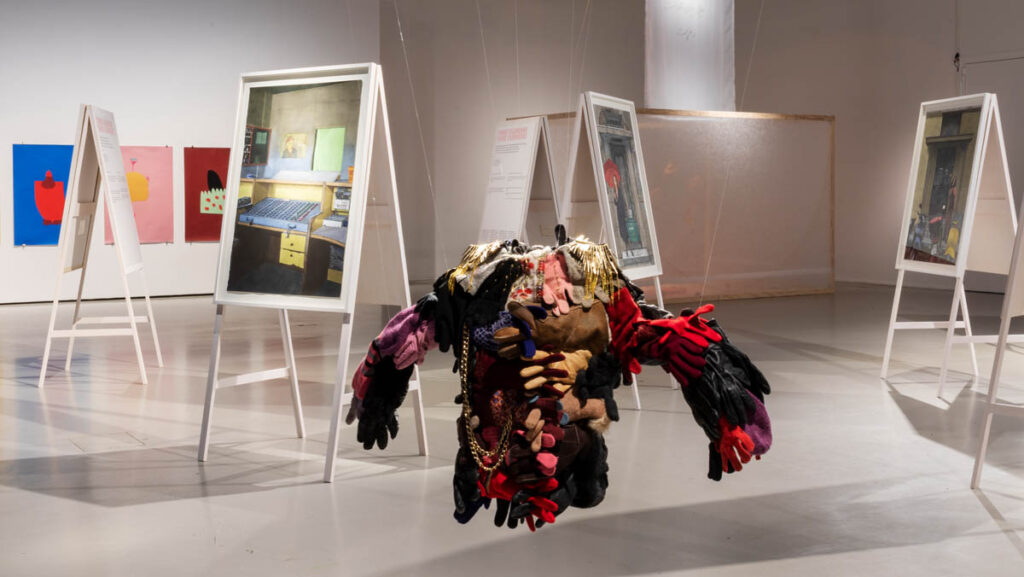
The Concept: The Parliament of Marmots
The exhibition is named after the Ladin Legend of the Fanes, which dates back to the transition from foraging societies to the emergence of agriculture, about 12,000 years ago. The legend tells the story of a mighty kingdom that eventually met its demise when a princess severed ties with the marmots because she was ashamed that humans and rodents were interacting as equals. The storyline of this magical Dolomitic legend is directly engaged by the artistic collective Atelier dell’ Errore in their design Marmot-Punk, part of the series Marmottoloide (2024). Covering the upper part of the paper, sitting on a long table, little biomorphic and geometric figures constitute the ‘parliament of marmots’. The table runs atop a fantastical weeping animal whose belly guards the last of the Fanes: human and non-human ancestors of the long-gone kingdom, who, according to the legend, went hiding underground. Marmot-Punk is a colourful, kaleidoscopic-like drawing that oscillates between figuration and abstraction, order and disorder. The visual interpretation of the myth captures the curatorial angle, according to which the transition from foraging to agriculture was a trajectory of disenchantment: the abandonment of ‘wilderness’, the vibrating essence of all life, as the mode of being in and with the world. This transition begot the organisation of large-scale, orderly systems of production, which was coterminous with the gradual hegemony of reason and the separation of the species, both of which still underline humans’ relation to the rest of the natural world. Revisiting the Ladin Legend of the Fanes, the exhibition is concerned with the ongoing collapse of life-supporting ecosystems and the urgency to contest human exceptionality. Brimming with figures that variously appear in many cultures, the legend also offered the exhibition’s geographic frame, which traverses the European continent as well as the Mediterranean regions of North Africa and the Middle East, from ‘the Moroccan, Algerian, Indonesia Atlas, to the Egyptian Sinai, to the mountains of Palestine and Lebanon, and up on to Turkey and Greece’.¹ The participating artists address three main vectors: in the words of the curator Lorenzo Giusti, ‘the wild as a creative dimension, multi-speciesism as a trajectory of becoming, and the mountain as a meeting ground and narrative dimension’.²

The exhibition can be best understood as part of the proliferating curatorial and artistic production of the last fifteen years that has sought to interrogate environmental collapse by adopting a post-humanist perspective. A widely diverse school of thought and artistic practice, post-humanism attempts to decentre the human as the sole creator and benefactor of history; it emphasises the liveliness, transformative creativity, and agency of all matter, and humans co-becoming with the rest of the organic and inorganic world. Surprisingly, The Parliament of Marmots is not a direct reference to late philosopher Bruno Latour’s concept of ‘the parliament of things’ but to a place on the Alpe di Fanes, Val Badia, where many marmots live, and near which the Last of the Fanes found their mythic refuge. Latour’s concept, which proposes that all ‘‘things’’ have agency, has had a profound impact on post-humanist philosophy and the development of ecologically conscious contemporary art. Donna Haraway, whose work shares epistemic similarities with Latour’s and is equally influential, was mentioned by Giusti during the press conference as being fundamental to the exhibition’s conceptualisation. Haraway advocates for living by ‚making kin‘ with the plurality of ‚earthlings‘; this is a mode of relating based on the assumed shared ontology of humans and non-human others: the shared substance that makes up the human body, a butterfly, and the mountains. A reenchanted world echoes throughout the exhibition.
The Artworks
Occupying indoor and outdoor spaces, from the streets of Ortisei to the plateaus and mystic mountains of the Dolomites, the exhibition was curated as a gesamtkunstwerk. I was left with the impression of an alternate world, in which human and non-human animals, streams of water, and lush vegetation appeared as fluid, transforming matter. For this review, the exhibition’s artworks could be divided into four categories: artworks that emphasise non-human perspectives; those that engage with ‘wilderness’ as the creative expression of all matter; those that foreground human and non-human relations; and artworks that bring together disparate geographies through the telling of stories about humans becoming with animals. A few examples:

Diana Policarpo’s Anguane’s Fountain (2024) is located in the courtyard of Castel Gardena. Rising from the centre of an ancient fountain, the sculpture resembles a fantastical blueish amoeba. The sculpture is dedicated to Anguanes, aquatic creatures and female guardians of nature in Ladin mythology. Policarpo evokes the replenishing of life as taking care–an act typically practised by women and, in this instance, imagined as a multi-species alliance. Not far from Anguane’s Fountain, Femmy Otten’s The Mountain and the Vulva (2024) comprises a large wooden vulva mounted to the corner of a wall that overlooks the mountains. This universal symbol of the (re)generation of life is extended to include, like in Policarpo’s fountain, caring for more-than-human worlds.


Farther from the mountains, in the centre of Ortisei, Nassim Azarzar’s The Edge of the Forest (2024) covers the façade of Hotel Ladinia in a colourful decorative pattern. As the interpretative text explains, Azarzar has created ‘‘‘another’’ world […] where the cultures of North Africa and the Alpine arc converge.’³ The mural, painted in the visual language that the artist developed during a long-term research project in Morocco, borrows from the legends of the Dolomites and the colourful shapes of North Africa to tell a story of entanglement between all living things. Sara Ouhaddou’s Les mains fertiles [Fertile hands] (2024) is on display in a shop window that typically showcases local craft to the tourists walking down Strada Rezia. Like Azarzar’s, Ouhaddou’s world, as little as a shop window, brings together the lands and techniques of the Dolomites with those of Morocco. Sara Ouhaddou collaborated with local sculptor Helene Demetzin to carve in the local technique tiny wooden animals indigenous to the Dolomites. Les mains fertiles draws on the zoomorphic pottery of Morocco: clay figurines that ‘may be used as toys, amulets and protectors for small children’, made by women sitting in front of the cooking fire.⁴

Eva Papamargariti’s A Whisper, a Murmur, a Roar (2024) is a three-channel video installation that combines born-digital images with filmed footage. The viewer assumes the perspective of a mythical creature (perhaps the hybrid of a butterfly and a wolf) on a transformative journey: the creature returns to its wildest nature as it immerses itself in the lush vegetation. At once ecstatic and menacing, the video asks, ‘how can we learn to let ourselves [become] ‘‘haunted’’ by the woods?’⁵


Esraa Elfeki’s What is beyond you (2024) is displayed in the natural history section of the Cësa di Ladins Museum Gherdëina. It consists of delicate and sparkling drawings of hybrid butterflies based on the engendered butterfly species that populate the mountains of Saint Catherine in Egypt and the Swiss Alps. The artist inserts her drawings in the cases typically used by natural history museums to order, display, and dissect non-human species. By contaminating the museum with a fantastical species that points to an alternate ‘elsewhere’, the artwork seems to subvert ‘taxonomy’, the classification system developed by Carl Linnaeus in his Systema Naturae (1735). Linnaeus’ foundational text organised the natural world by separating it into animal and plant species that were clearly distinguished from the human one. This “System of Nature” entailed a hierarchical ordering amongst species, and also amongst humans themselves. It formalised both speciesism and so-called scientific racism, both of which have provided the intellectual justification for growth-driven colonialism and its practices of expropriation of racialised and gendered labour, as well as extractivism.

Linda Jasmin’s Mayer, Drifters (2024) complements What is Beyond You by reappropriating the figure of the ‘wild man’, marginalised in Linnaeus’ system. Anthropomorphic masks (made in collaboration with set designer Andrea Ferri), suspended from the ceiling of Spazio Ferdinand Stuflesser, resemble otherworldly marine-like creatures. Delicate, ethereal, and translucent, the creatures seem to move, twist, and flow in a constant state of metamorphosis. Indeed, Jasmin has drawn inspiration from plankton, tiny aquatic organisms that cannot direct their movement but drift together with the flows of the water. The masks allude to the geological formation of the Dolomites, which was due to the deposition of marine fossils, accumulated through the course of millions of years, and to the legend of the ‘wild man’ whose uninhabited creativity was ‘‘activated’’ through carnivalesque rituals across Europe. (The anthropomorphic masks exhibited in The Parliament of Marmots were worn in a performance during the opening of the exhibition)
A Question
The question troubling me was: can re-enchantment save the world? In other words, can we, by emphasising the ‚animal‘ or the ‚wild‘ as the fundamental essence of all life, including humans, explain the causes of environmental degradation? Can we rescue what remains of ’nature‘ by giving space to the more-than-human, embracing ‚wilderness‘, and challenging the taxonomic categorisation of species as defined by Linnaeus? Can forming a closer bond with the vibrancy of the world help us uncover and challenge the inequalities that exist between geographies historically separated and taxonomically categorised as ‚first‘, ’second‘, and ‚third‘ worlds? To be clear, I do not suggest that the artistic imaginaries of ethical relating are redundant–indeed, we live in times of manifest cruelty to non-human animals–but that an ethical relating predicated on the understanding that humans are not exceptional may not take us very far.
Indeed, in his curatorial statement, the curator himself describes our era as the Capitalocene, a term that is counterposed, often polemically, to the widely used concept of the Anthropocene. The latter, derived from the Greek word for ‘human’ (anthropos), is the proposed name of the geological era during which human activity has been reshaping the earth system in its entirety. Rather than holding (an abstract) humanity responsible for the unfolding ecological catastrophe, the lens of ‘Capitalocene’ helps to realise that this catastrophe is driven by the very processes that formed industrial capitalism (e.g., the burning of fossil fuels and extraction of minerals), and, also, that the collapse of our planet’s life-supporting systems is felt unequally by peoples at the intersection of taxonomic, classed, gendered, and racialised oppressions. People living in Burkina Faso, for instance, do not even remotely engage with the rates of over-consumption ‘‘enjoyed’’ in the West; yet, they face an existential ecological thread, arguably, stemming from ecological neo-colonialism.


This said, relatively few artworks – all loans – explore the larger systemic foundations that shape the ‘nature’–human relation, as well as the exceptional human effort required to facilitate a meaningful, systematic, and planetary-wide change. Dedicated to the late Lin May Saeed, an animal rights activist, the exhibition is gentle and powerful, affective and revolting, ‘‘non-human’’ and distinctively ‘‘human’’. Saeed’s small retrospective included life-size animals standing victorious on top of cages, animals positioned on pedestals and as part of relief sculptures (both typically reserved for the representation of humans), as well as tiny creatures perching in niches. For me, the most telling and haunting objects were The Liberation of Animals from their Cages XV (2014), made of steel twisted to represent an activist carrying in their arms a sheep released from captivity; and Reiniger / Cleaner (2006), a large wooden cage on which kneels a ghostly figure – someone looking like a human from the future, in a protective mask and white overalls, holding a dying animal in their amputated arms.
![Nadim Choufi, A Future Perfect [sic] Life, 2020, Still from Video. Courtesy of the artist](https://www.les-nouveaux-riches.com/wp-content/uploads/the-parliament-of-marmots-12-1200x652.jpg)
Nadim Choufi’s A Future Perfect [sic] Life (2020), on display at Spazio Ferdianand Stuflesser, is a performance lecture that unpacks capitalism’s drive to overcome ‘‘natural’’ barriers by manipulating the materiality of life, including plans for space colonisation, the great exodus to Mars, sponsored by capitalists like Elon Musk, and the construction of bunkers in remote parts of the world that will ensure the perpetuation of the human species – that is the chosen white middle-class few – in the aftermath of destruction. Revealing the causal link between capitalism and environmental destruction, A Future Perfect… includes a clip originally displayed at the Museum of the Futurein Dubai and framed as a futurist advertisement of the United Arab Emirates (UAE) that sells solutions to the problems caused by economies based on growth, Dubai’s included. The pompous voice in the video narrates: ‘forests turned to dust, people suffering, cities in ruins, we face great climate risks, but the UAE [United Arab Emirates] saw an opportunity to move fast and create breakthroughs that the world has never seen. We solved our own problems and now climate solutions are our greatest exports. Welcome to Dubai 2050.’


Shuruq Harb’s In the Presence of Absence (2024), located near A Future Perfect…, similarly interrogates the social relations that traverse the disparate geographies and lives that embody the impact of catastrophic ‘‘human’’ expansionism – the artist ‘revisits the notion of absence, love, longing, Palestine, history, friendship, and the relation between life and death’.⁶ The film includes footage from the outskirts of Ramallah, Palestine’s administrative capital. Slow and meditative, the camera focuses on a massive rock as the scene transitions from darkness to light; the camera slowly moves over the rock, Mediterranean trees, and the sky. The pace picks up gradually as we are brought to an open-pit mine where a solitary worker works the earth, to broad views that resemble the relics of an old settlement, and to the environs of a quarry. Those could be visions of Palestine’s stone and marble industry, which, in addition to having a substantial environmental impact, employed thousands of people and contributed significantly to the country’s revenue. These are eerie landscapes of extraction, destruction, and desolation.
During the press conference, Giusti emphasised that choosing an extensive geographical frame was not only a curatorial device but also a political statement. Although the enchanted stories that The Parliament of Marmots told might not have offered a clear path for addressing the deep divisions in our Capitalocene world, during the exhibition opening, three artists expressed their opposition to the ongoing genocide of the Palestinian people. How to connect Europe and the ‘mountains of Palestine’ without considering the systemic issues that can make life impossible?
Biennale Gherdëina 9 – www.biennalegherdeina.org
¹ Lorenzo Giusti during the press conference, 30/05/24.
² As described in the press announcement.
³ Quote from the interpretative text; available online: www.biennalegherdeina.it/nassim-azarzar/
⁴ Quote from the interpretative text; available online: www.biennalegherdeina.it/sara-ouhaddou/
⁵ Quote from the interpretative text; available online: www.biennalegherdeina.it/eva-papamargariti/
⁶ Quote from the interpretative text; available online: www.biennalegherdeina.it/shuruq-harb/





